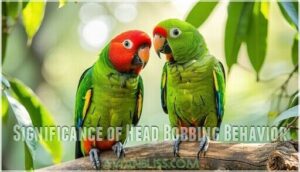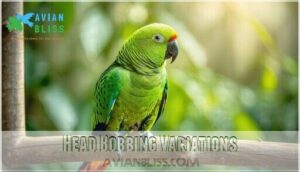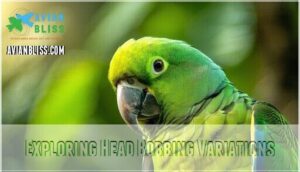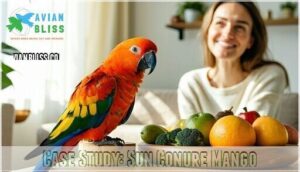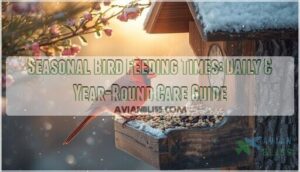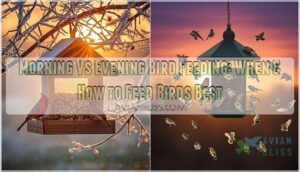This site is supported by our readers. We may earn a commission, at no cost to you, if you purchase through links.
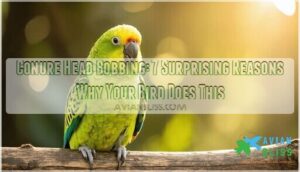
You’ll notice variations in speed and intensity depending on your bird’s mood and environment. Fast, enthusiastic bobbing often means they’re thrilled about music, food, or playtime.
Slower, deliberate movements might indicate they’re establishing dominance or responding to perceived threats. Context matters: bobbing during social interaction typically shows positive engagement, while cage-related bobbing could signal territorial instincts.
Understanding these patterns helps you recognize when your conure feels content versus stressed, turning their adorable dance into meaningful conversation. This understanding is crucial for building a strong bond with your bird, based on mutual respect and clear communication.
Table Of Contents
- Key Takeaways
- Understanding Conure Head Bobbing
- Triggers and Influences
- Significance of Head Bobbing Behavior
- Decoding Conure Body Language
- Factors Behind Head Movement
- Observing Happy Conures
- Exploring Head Bobbing Variations
- Case Study: Sun Conure Mango
- Frequently Asked Questions (FAQs)
- What does it mean if a bird is bobbing its head?
- Are birds happy when they bob their head?
- What does it mean when a conure bobs its head up?
- Why is my bird bobbing its head?
- How do I know if my conure is happy?
- What does it mean when a conure is dancing?
- Can head bobbing signal mating interest?
- What toys encourage head bobbing in conures?
- Does diet affect head bobbing frequency?
- Are certain genders more prone to head bobbing?
- Conclusion
Key Takeaways
- You can decode your conure’s mood through head bobbing patterns – fast, enthusiastic bobbing signals excitement about food or play, while slower movements often indicate territorial behavior or dominance displays.
- Head bobbing is your conure’s primary communication tool – it’s how they express happiness, seek attention, show affection, or signal they want treats, making it essential for building a strong bond.
- Context matters when interpreting the behavior – bobbing during social interaction typically shows positive engagement, while cage-related bobbing might indicate territorial instincts or stress responses.
- Environmental factors directly influence bobbing frequency – cramped cage space, poor lighting, insufficient toys, and excessive noise can trigger stress-related head bobbing, while proper conditions promote happy, rhythmic movements.
Understanding Conure Head Bobbing
Head bobbing behavior catches your eye for good reason—it’s your conure’s primary communication tool. This rhythmic movement represents complete normalcy in parrot behavior, typically signaling happiness, excitement, or contentment.
Your bird might bob when anticipating playtime, receiving attention, or simply feeling secure in their environment. The parrot head bob serves multiple purposes in bird body language.
Sometimes it’s an affection display toward you or other birds, while other times it functions as begging behavior when your conure wants food or treats. This conure behavior stems from their strong social requirements—these naturally flock-oriented birds use head bobbing to maintain connections with their companions.
Budgies also use this behavior, and it can be a key part of courtship displays.
Understanding head bobbing meaning helps you recognize your bird’s emotional state. The movements can range from gentle, slow bobs during calm moments to rapid, enthusiastic bouncing when extremely excited.
Pay attention to the context—timing, intensity, and accompanying vocalizations all provide clues about what your conure head bobbing really means in each situation.
Triggers and Influences
Your conure’s head bobbing doesn’t happen randomly – specific triggers in their environment and emotional state drive this fascinating behavior.
Understanding these influences helps you recognize when your bird is simply expressing joy versus signaling a need for attention or care.
Environmental Factors
Environmental factors play a vital role in conure head bobbing behavior. Your bird’s surroundings directly influence their comfort and stress levels, which manifest through physical behaviors like head movements.
Consider these key environmental elements that affect conure head bobbing:
- Cage Size – Cramped spaces increase stress in birds and can trigger excessive bobbing as a coping mechanism
- Lighting Quality – Poor or inconsistent lighting disrupts natural rhythms and causes behavioral changes
- Toy Variety – Insufficient mental stimulation leads to bird boredom and repetitive behaviors
- Noise Levels – Excessive sounds create environmental stress, while complete silence can cause anxiety
Proper perch placement also matters for your conure’s comfort. Ensuring your bird has adequate cage dimensions is crucial for their well-being. These bird environmental stimuli work together to create either a calming atmosphere or one that promotes stress-related head bobbing patterns.
Emotional States
Something special happens when you watch your feathered friend’s head bobbing – it’s pure emotional expression in action.
Conure happiness shines through rhythmic movements, while seeking attention drives those adorable up-and-down motions.
Whether it’s playful behavior, expressing needs, or even mating rituals, your bird’s emotional state speaks volumes.
This conure emotional expression helps you decode their inner world perfectly.
Significance of Head Bobbing Behavior
Why does your conure bob its head with such enthusiasm? This head bobbing behavior serves as a primary communication form and social signal among conures.
When your bird displays these rhythmic movements, it’s engaging in bonding rituals and showing affection display toward you or other birds. The emotional expression behind head bobbing reveals your conure’s contentment and keenness to connect.
This behavior often indicates mating interest during breeding seasons, particularly in males attempting to court potential partners. Understanding these head bobbing variations helps you decode your bird’s social dynamics and emotional state.
When paired with vocalizations or wing fluttering, head bobbing becomes an even stronger indicator of excitement and happiness. Conures use this behavior to request attention, express joy, or signal their readiness for interaction with their human flock members.
Decoding Conure Body Language
You’ll notice your conure’s head bobbing comes with other visual signals that reveal their true intentions.
The speed, direction, and accompanying body postures tell a complete story about what your feathered friend is trying to communicate, using visual signals.
Visual Cues
Your conure’s body language speaks volumes beyond head bobbing, revealing emotions through subtle visual cues.
Watch for feather displays that signal excitement or stress, plus eye dilation indicating alertness or fear. Body orientation shows interest levels, while wing signals communicate territorial boundaries.
- Feather displays: Raised crests show excitement, fluffed feathers indicate comfort
- Eye dilation: Pinning eyes reveal high emotion or overstimulation
- Posture changes: Upright stance signals alertness, hunched position shows relaxation
- Wing signals: Slightly lifted wings indicate readiness to interact or mild aggression
These visual cues work alongside conure communication patterns, helping you decode your bird’s mood and needs through careful observation of bird body language signals.
Head Bobbing Variations
Your conure’s head bobbing displays fascinating rhythmic differences and intensity levels that reveal their emotional state.
Bobbing speed varies dramatically – gentle, slow movements during contentment versus rapid, vigorous jerks when excited. Individual styles emerge as each bird develops unique patterns.
Contextual bobbing matters most: rapid movements during playtime signal joy, while steady rhythms indicate social bonding attempts. These emotions translate into distinct bird language through movement variations.
Some conures prefer circular motions during courtship, others stick to vertical bobs. Pay attention to your bird’s personal headbobbing signature – it’s their way of expressing conure head bobbing preferences and personality quirks.
It may also be a normal behavior linked to attention seeking.
Factors Behind Head Movement
Your conure’s head movement stems from specific external stimuli and emotional responses that trigger this natural behavior.
Understanding these factors helps you recognize whether your bird is communicating excitement, seeking attention, or responding to environmental changes around them.
External Stimuli
Multiple external stimuli can trigger conure headbobbing episodes in your feathered companion. Your bird’s environment contains countless Auditory Triggers and Visual Stimuli that spark this fascinating behavior.
When you approach with treats or create environmental sounds, you’ll witness immediate responses. Tactile Input from new perches also influences movement patterns. Head bobbing can also be attributed to underlying neurological disorders.
Here’s what commonly triggers headbobbing:
- Favorite treats – Millet sprays and sunflower seeds create excitement through Taste Perception
- Music and rhythmic sounds – Your bird synchronizes movements with beats and melodies
- Colorful toys – Bright objects near the cage prompt investigative bobbing through curiosity
- Human interaction – Your presence acts as powerful social stimulation during play activities
Olfactory Influence from cooking or new scents can also initiate responses, demonstrating how external stimuli create complex behavioral patterns.
Emotional Responses
Behind their adorable head bobbing, your conure’s emotional state drives this fascinating behavior.
Expressing contentment through gentle bobs signals your bird feels secure, while rapid movements often indicate seeking attention or bird excitement.
Displaying affection occurs during bonding moments, especially when paired with soft vocalizations.
Signaling playfulness emerges through rhythmic head movements, showing your conure’s ready for interaction.
Reflecting happiness and bird emotional state becomes evident when bobbing accompanies dancing or strutting.
Understanding these conure behavior patterns helps distinguish between joyful bird happiness and potential bird stress signals.
Observing Happy Conures
Recognizing happiness indicators in your feathered friend starts with understanding their unique body language.
Happy conures display distinct contentment signs through energetic playful interactions and enthusiastic head movements.
You’ll notice satisfied birds bobbing rhythmically while perched, engaging with toys, or anticipating favorite treats like sunflower seeds.
These joyful displays extend beyond simple head movement.
Watch for hopping behavior, clothing exploration, and circular head swaying—all classic conure personality traits that signal trust and security.
Bonding displays often accompany vocal communication, creating a symphony of squeaks and chatter that strengthens your relationship.
Conure attention seeking through head bobbing typically occurs during positive reinforcement moments, like treat time or social interaction.
Pay attention to conure social cues such as relaxed postures, active engagement with their environment, and keen participation in daily activities.
These behavioral patterns indicate emotional well-being and demonstrate your bird’s comfort level.
Understanding these signals helps you recognize when your conure feels genuinely content and secure in their surroundings.
Exploring Head Bobbing Variations
Observing your feathered friend’s movements reveals distinct patterns that speak volumes about their emotional state. Rhythmic Intensity varies substantially – gentle, slow bobs often indicate contentment, while rapid movements suggest excitement or overstimulation. Bobbing Speed accelerates during feeding time or when your conure spots something interesting.
Angle Variation matters too. Up-and-down motions typically signal hunger or playfulness, especially in younger birds mimicking nestling behavior. Side-to-side movements often relate to courtship displays or social interaction attempts. Contextual Bobbing depends heavily on surroundings – music might trigger rhythmic dancing, while new objects prompt investigative head tilts.
Each bird develops Individual Styles reflecting their unique personality. Some conures prefer subtle wobbles, others display dramatic gestures. These conure social cues form part of complex bird social behavior patterns. Head bobbing can also be a key part of budgie social dynamics.
Understanding these conure personality traits through bird nonverbal cues helps you decode their bird body language more effectively. Your conure’s head movements aren’t random – they’re purposeful communication tools expressing everything from joy to curiosity to mild annoyance.
Case Study: Sun Conure Mango
Meet Mango, a vibrant Sun Conure whose head bobbing tells a fascinating story about conure behavior. When you observe Mango’s rhythmic movements, you’re witnessing complex parrot behavior patterns in action.
Mangos Environment plays a vital role in his head bobbing frequency. Sarah noticed three key triggers that amplify his enthusiastic displays:
- Mangos Socialization needs kick in when she enters the room, triggering excited bobbing
- Favorite treats from Mangos Diet spark rapid up-and-down movements with cheerful chirping
- Background music transforms bobbing into synchronized "dancing" behavior
Mangos Training sessions reveal how head bobbing serves as nonverbal communication. He’ll lock eyes with Sarah while bobbing intensely, basically saying "Pay attention to me!" This bird behavior demonstrates the strong affection bonds Sun Conures form with their owners. Sun conures, unlike jendays, bond with families.
Mangos Health appears pristine when his head bobbing accompanies vocalizations, indicating contentment rather than distress. This case study perfectly illustrates how understanding your conure’s unique bobbing patterns helps decode their emotional state and strengthen your relationship.
Frequently Asked Questions (FAQs)
What does it mean if a bird is bobbing its head?
Telegram-style notifications aren’t needed here—your bird’s head bobbing typically signals excitement, happiness, or communication attempts.
It’s normal social behavior where they’re expressing emotions, seeking attention, or responding to environmental stimuli like sounds or interactions, which can include communication attempts.
Are birds happy when they bob their head?
Yes, head bobbing usually indicates happiness in birds. It’s their way of showing excitement, contentment, and social bonding. However, excessive bobbing might signal health issues, so watch for other symptoms.
What does it mean when a conure bobs its head up?
Like a tiny metronome keeping time, your conure’s upward head bobbing typically signals excitement, happiness, or attention-seeking behavior.
It’s their way of saying "Hey, look at me!" or expressing pure joy about something interesting.
Why is my bird bobbing its head?
Your bird’s head bobbing typically signals happiness, excitement, or attention-seeking behavior.
It’s a normal communication method expressing contentment, playfulness, or social bonding.
However, excessive bobbing with breathing difficulties warrants veterinary attention.
How do I know if my conure is happy?
You’ll know your conure’s happy when it head-bobs rhythmically, vocalizes cheerfully, plays actively with toys, preens regularly, and seeks interaction with you—these behaviors signal contentment and emotional well-being.
What does it mean when a conure is dancing?
Dancing conures exhibit rhythmic movements, swaying, head-bobbing, and foot-tapping that signal excitement, happiness, or playfulness.
You’re witnessing their natural communication style – they’re expressing joy, seeking attention, or responding to music and environmental stimuli around them, which is a sign of their playfulness.
Can head bobbing signal mating interest?
Yes, head bobbing commonly signals mating interest in conures.
It’s a primary courtship display, especially in males trying to attract mates during breeding season.
This rhythmic behavior often accompanies vocalizations and shows hormonal readiness for reproduction.
What toys encourage head bobbing in conures?
Interactive toys spark head bobbing naturally – think swinging perches, bells, and mirrors.
You’ll notice bobbing increases with rhythmic toys, musical gadgets, and colorful objects that move when touched, encouraging your conure’s playful communication instincts.
Does diet affect head bobbing frequency?
Diet plays a vital role in your conure’s head bobbing frequency. Well-fed birds typically bob less since head bobbing often signals begging behavior when they’re hungry or seeking treats.
Are certain genders more prone to head bobbing?
Males typically show more frequent head bobbing during breeding season as part of courtship displays, though both genders exhibit this normal communication behavior regularly throughout the year.
Conclusion
Like a well-tuned orchestra responding to its conductor, your conure’s head bobbing reflects their internal emotional state and environmental awareness.
Understanding conure head bobbing patterns helps you decode your bird’s communication signals and respond appropriately to their needs.
Whether expressing excitement, establishing territory, or seeking attention, these rhythmic movements provide valuable insights into your pet’s wellbeing.
By recognizing the subtle differences in speed, intensity, and context, you’ll strengthen your bond and create a more harmonious relationship with your feathered companion, and improve your understanding of their emotional state and environmental awareness.
- https://www.parrotforums.com/threads/is-something-stuck-conure-is-vigorously-bobbing-head-up-in-down.71124/
- https://www.youtube.com/watch?v=lv7QQhLW5FU
- https://forums.avianavenue.com/index.php?threads%2Fconure-head-bobbing.126760%2F
- https://www.talkparrotlets.com/threads/side-to-side-bobbing.3973/
- https://www.reddit.com/r/parrots/comments/qr8s3j/is_this_head_bobbing_normal_behaviour_for_a/


